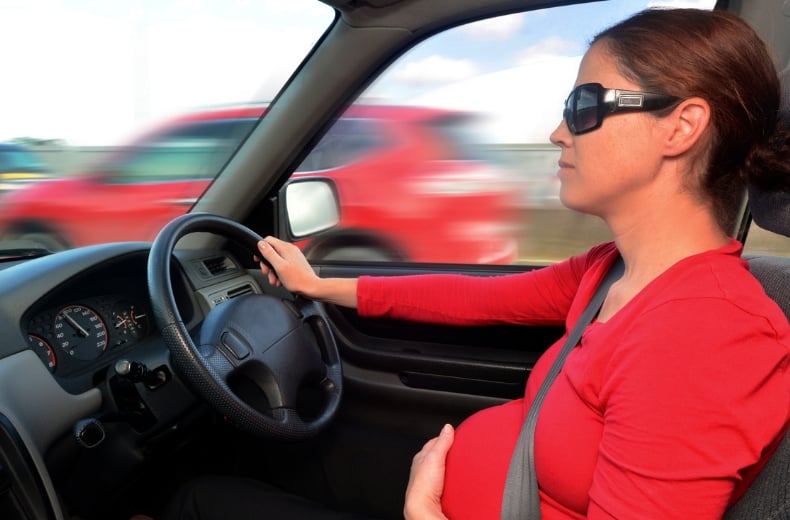Are you fit to be behind the wheel?
It’s your legal responsibility to ensure you’re able to drive safely and to notify the DVLA if you have a condition that could affect this.
Failure to disclose could land you with a £1,000 fine, so we take you through some key questions to determine whether or not you should be driving.

RAC Breakdown Cover
With our cover, the difference is in your pocket.
*£7 a month for new, single vehicle Basic. ^For 1 vehicle with new Extra or Complete. Excludes Basic. Ends 28/05/24, 7am.

Should I be driving while pregnant?

Expecting a baby shouldn’t stop you driving as normal for most of your pregnancy.
The BabyCentre says it’s fine to drive as long as you’re comfortable and can manoeuvre safely.
However, there are some things to bear in mind.
In the early stages of your pregnancy, you might experience morning sickness and have to pull over if you start to feel nauseous while driving.
Extreme fatigue can make it harder to concentrate, so you should only drive when you’re feeling alert.
The BabyCentre advises taking a break at least every 90 minutes on long journeys, particularly if you’re suffering from swollen ankles and leg cramps.
Towards the end of your pregnancy, your growing bump may feel uncomfortable and get in the way of the steering wheel.
If that’s the case, you might prefer to stop driving, but there’s no law saying you must.
If you’re suffering from swollen ankles or cramp in your legs, it’s best to avoid long drives without stops.
You must still wear a seat belt when you’re pregnant unless you have a doctor’s note.
It’s also a good idea to keep your car well maintained to prevent a highly-inconvenient breakdown while you’re travelling.
READ MORE: Seat belt law – how to keep safe and avoid fines
Should I be driving with poor eyesight?
Are you one of the thousands of UK motorists driving illegally because of poor vision?
The DVLA says almost 45,000 drivers have had their licence revoked or refused since 2012 because their eyesight didn’t meet legal requirements.
It’s illegal to drive if you can’t read a standard number plate from a distance of 20 metres.
It was recently announced that three police forces in the UK will test the vision of all motorists stopped in a crackdown on defective eyesight.
Changes in vision can occur with age, with cataracts, glaucoma and diabetes all common in older people. At night, you might be dazzled by glare from oncoming headlights and street lights.
According to DVLA guidelines, having an eye condition doesn’t mean you’ll be banned from driving.
However, if you’re involved in an accident and found to have an undeclared ‘notifiable’ medical condition or disability, you could be prosecuted and your insurance cover invalidated.
Health professionals recommend having an eye test every two years.
This will help to ensure you meet the minimum eyesight standards for driving and will usually identify common eye conditions at an early stage.
If you wear glasses or contact lenses for driving, make sure your prescription is correct, otherwise you still might not meet the legal requirements.
5 Star Defaqto rated cover
RAC Comprehensive Car Insurance Plus has been given a 5 Star Rating by Defaqto. Get a quote online today.


Should I be driving with a cold or flu?
Coughs and sniffles affect us all from time to time but getting behind the wheel with a nasty cold can be as bad as drink-driving.
Previous research from Cardiff University’s Common Cold Centre found that concentration levels when driving with a bad cold or flu drop by more than 50%.
Shockingly, that’s the equivalent of downing more than four double whiskies.
The symptoms of a cold, including runny noses, headaches, tiredness and irritation around the nose and eyes, all tend to reduce awareness.
The researchers found that reaction times dropped significantly, and sudden braking became a lot more frequent, as drivers with bad colds were less aware of their surroundings.
Sniffly motorists were also 30% more likely to hit the kerb because they were less capable of judging distance.
Should I be driving on medication?
Driving while under the weather is risky, but cold and flu remedies can compound the problem as some medicines can cause side effects such as drowsiness, blurred vision and poor concentration levels.
Another problem medication is codeine, a common treatment for pain.
It can slow down reaction times and lead to loss of focus in many people.
Antihistamines taken to alleviate the effects of hay fever can also make you feel drowsy, lightheaded or less alert than usual.
UK law states that if you’re stopped by the police, they can ask you to do a ‘field impairment assessment’ and take a roadside drugalyser test.
If they think you’re unfit to drive, you could be prosecuted.
A conviction for drug-driving carries a minimum one-year driving ban and an unlimited fine.
In extreme cases, you could receive a six-month jail sentence.
If you do drive while on medication, always check the label carefully and pay attention to any warnings or ask your pharmacist about medicines you buy over the counter.
It’s best to avoid driving altogether if you feel drowsy or lightheaded.
READ MORE: Why you might not be drinking enough before getting behind the wheel
Should I be driving in older age?

There’s no legal age at which you must stop driving, and hopefully you’ll still be able to enjoy the freedom of getting behind the wheel long into your retirement.
While your licence expires when you turn 70, you just have to keep renewing it every three years if you want to continue driving.
However, as you age you may find your reaction times become slower and your joints get stiffer, making it harder to twist your head to look round or turn the steering wheel quickly.
Try to keep physically active to maintain your strength and flexibility.
It could also help to drive a car with automatic transmission, power steering and large mirrors.
If you’re concerned that your driving isn’t as good as it used to be and you’re worried that you’re putting yourself and other road users in danger, stop before you have an accident.
According to DVLA guidelines, it might be time you give up driving if:
- Your reactions are noticeably slower than they used to be
- You find traffic conditions increasingly stressful
- You’re struggling to see traffic lights and street signs
- You have a medical condition that may affect your ability to drive safely
Should I be driving with a sleep disorder?
One in 20 drivers unknowingly suffers from sleep apnoea, a sleeping disorder that increases the risk of nodding off at the wheel, according to research by the RAC in conjunction with the Sleep Apnoea Partnership Group
It’s believed that drivers with untreated obstructive sleep apnoea are up to 10 times more likely to have a road accident.
Sleep apnoea occurs when the muscles in the mouth, nose and throat relax during sleep, reducing airflow and causing snoring.
If the airways close completely, breathing stops for a few seconds and the lack of oxygen forces you to wake up.
This can happen several times a night, disrupting your sleep cycle and causing you to miss out on those all-important deep phases of sleep.
As a result, you may feel exhausted during the daytime.
Never drive if you feel sleepy.
If the problem is severe, your GP can refer you to a sleep specialist.
READ NEXT: Seven things you should never do when driving a manual car
Did you know, you can get fined for moving out of the way of an ambulance?
Want more useful content like this sent straight to your inbox?






